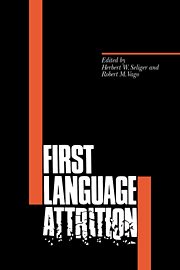Book contents
- Frontmatter
- Contents
- List of figures
- List of tables
- List of contributors
- Acknowledgment
- Part I Survey studies
- 1 The study of first language attrition: an overview
- 2 First language attrition and the parameter setting model
- 3 Recapitulation, regression, and language loss
- 4 First language loss in bilingual and polyglot aphasics
- 5 A crosslinguistic study of language contact and language attrition
- Part II Group studies
- Part III Case studies
- Index
3 - Recapitulation, regression, and language loss
Published online by Cambridge University Press: 14 January 2010
- Frontmatter
- Contents
- List of figures
- List of tables
- List of contributors
- Acknowledgment
- Part I Survey studies
- 1 The study of first language attrition: an overview
- 2 First language attrition and the parameter setting model
- 3 Recapitulation, regression, and language loss
- 4 First language loss in bilingual and polyglot aphasics
- 5 A crosslinguistic study of language contact and language attrition
- Part II Group studies
- Part III Case studies
- Index
Summary
Introduction
Roman Jakobson opens his monograph Kindersprache, Aphasie und allgemeine Lautgesetze with a quotation from Karl Bühler: “Die einzige Gelegenheit die wir haben, die menschliche Sprache in statu nascendi zu beobachten, bietet das Kind,” and he himself adds: “Die einzige Gelegenheit die wir haben, die menschliche Sprache im Abbau zu beobachten, bieten die pathologischen Sprachstörungen zentraler Natur” (Jakobson 1941: 348).
In his article Jakobson sketches parellels between three processes of language change: diachronic language change, first language acquisition, and language loss as a result of brain damage. He argues that parallels between these three processes suggest that there are universal mechanisms in language. He provides evidence to show that phonemes should be looked upon as bundles of features, and that in all three processes distinctive features rather than individual phonemes play a role. In his view, those features that are acquired late are also relatively uncommon in natural language, and early candidates for attrition. Although his evidence is largely phonological, Jakobson assumes that there are universals at other linguistic levels as well.
The supposed parallels between language history and first language acquisition (or second language acquisition, for that matter) are usually labelled as the recapitulation hypothesis; the supposed parallelism between language acquisition and language loss as the regression hypothesis.
Both hypotheses have been the object of some linguistic research. In this paper we will examine whether parallels between language acquisition and diachronic language change can indeed be interpreted as recapitulation.
- Type
- Chapter
- Information
- First Language Attrition , pp. 31 - 52Publisher: Cambridge University PressPrint publication year: 1991
- 20
- Cited by



